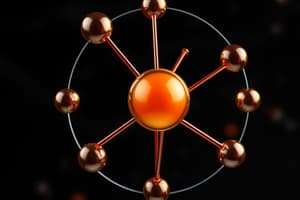Podcast
Questions and Answers
What is the primary purpose of a chemical bond?
What is the primary purpose of a chemical bond?
- To create a new molecule
- To become stable (correct)
- To increase the number of electrons in the valence shell
- To decrease the electronegativity of an atom
Which of the following atoms is stable with 2 electrons in its valence shell?
Which of the following atoms is stable with 2 electrons in its valence shell?
- Oxygen
- Nitrogen
- Carbon
- Helium (correct)
What is the difference in electronegativities between atoms in an ionic bond?
What is the difference in electronegativities between atoms in an ionic bond?
- Greater than 1.7 (correct)
- Less than 0.5
- Equal to 0
- Between 0.5 and 1.7
Which type of bond occurs when a metal atom bonds with a non-metal atom?
Which type of bond occurs when a metal atom bonds with a non-metal atom?
What is characteristic of a covalent bond?
What is characteristic of a covalent bond?
What is an example of a non-polar covalent bond?
What is an example of a non-polar covalent bond?
What is the characteristic of a polar covalent bond?
What is the characteristic of a polar covalent bond?
What is a characteristic of metallic bonds?
What is a characteristic of metallic bonds?
Flashcards are hidden until you start studying
Study Notes
Types of Chemical Bonds
- A chemical bond is the union of two atoms, which can be the same or different, with the purpose of becoming stable.
Atomic Stability
- According to Lewis, atoms are stable when they have 8 electrons in their valence shell, except for hydrogen and helium, which are stable with 2 electrons.
Types of Chemical Bonds
- There are three types of chemical bonds: ionic, covalent, and metallic.
Ionic Bond
- An ionic bond occurs when a metal atom bonds with a non-metal atom.
- The difference in electronegativities between the atoms is greater than 1.7.
- One of the atoms loses an electron, which is attracted by the more electronegative atom.
- Example: sodium chloride (NaCl), where sodium loses an electron to chlorine.
Covalent Bond
- A covalent bond occurs when two non-metal atoms bond.
- The characteristic of a covalent bond is that neither atom loses or gains an electron, but instead, they share electrons.
- There are three types of covalent bonds: non-polar, polar, and coordinate.
Non-Polar Covalent Bond
- A non-polar covalent bond occurs when two identical atoms bond.
- Example: hydrogen molecule (H2), where two hydrogen atoms share electrons to become stable.
Polar Covalent Bond
- A polar covalent bond occurs when two different non-metal atoms bond.
- The difference in electronegativities between the atoms is greater than zero but less than 1.7.
- Example: water molecule (H2O), where oxygen attracts the electrons from hydrogen to complete its octet.
Metallic Bond
- A metallic bond occurs when metal atoms bond with each other.
- Metal atoms are bonded together, forming a "sea of electrons" that allows metals to conduct electricity, heat, and have a characteristic luster.
Chemical Bonds
- Chemical bonds form to achieve atomic stability, which is attained when atoms have 8 electrons in their valence shell (except for hydrogen and helium, which are stable with 2 electrons).
Types of Chemical Bonds
- There are three types of chemical bonds: ionic, covalent, and metallic.
Ionic Bonds
- Formed between a metal atom and a non-metal atom.
- Characterized by a large difference in electronegativities (>1.7) between the atoms.
- One atom loses an electron, which is attracted by the more electronegative atom.
- Example: sodium chloride (NaCl), where sodium loses an electron to chlorine.
Covalent Bonds
- Formed between two non-metal atoms.
- Characterized by sharing electrons between atoms.
- Three types of covalent bonds: non-polar, polar, and coordinate.
Non-Polar Covalent Bonds
- Formed between two identical atoms.
- Example: hydrogen molecule (H2), where two hydrogen atoms share electrons to become stable.
Polar Covalent Bonds
- Formed between two different non-metal atoms.
- Characterized by a difference in electronegativities (>0 but <1.7) between the atoms.
- Example: water molecule (H2O), where oxygen attracts electrons from hydrogen to complete its octet.
Metallic Bonds
- Formed between metal atoms.
- Characterized by a "sea of electrons" that allows metals to conduct electricity, heat, and have a characteristic luster.
Studying That Suits You
Use AI to generate personalized quizzes and flashcards to suit your learning preferences.




